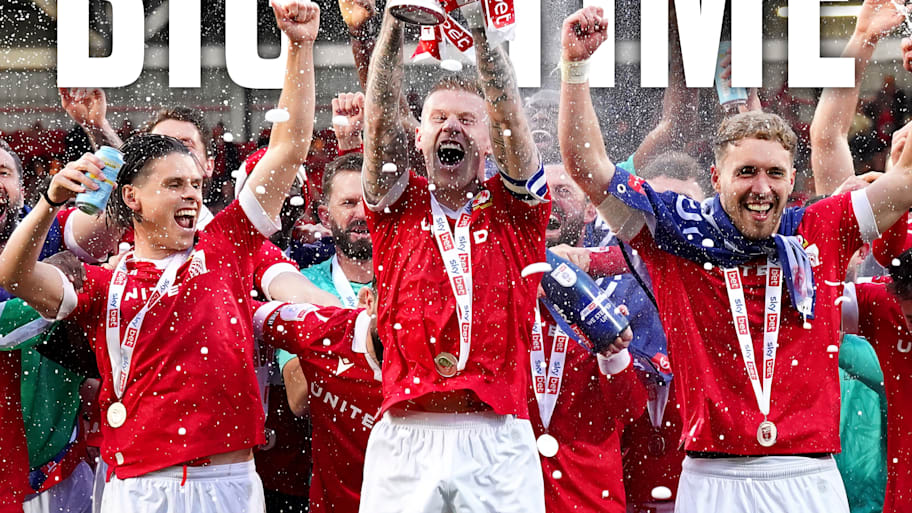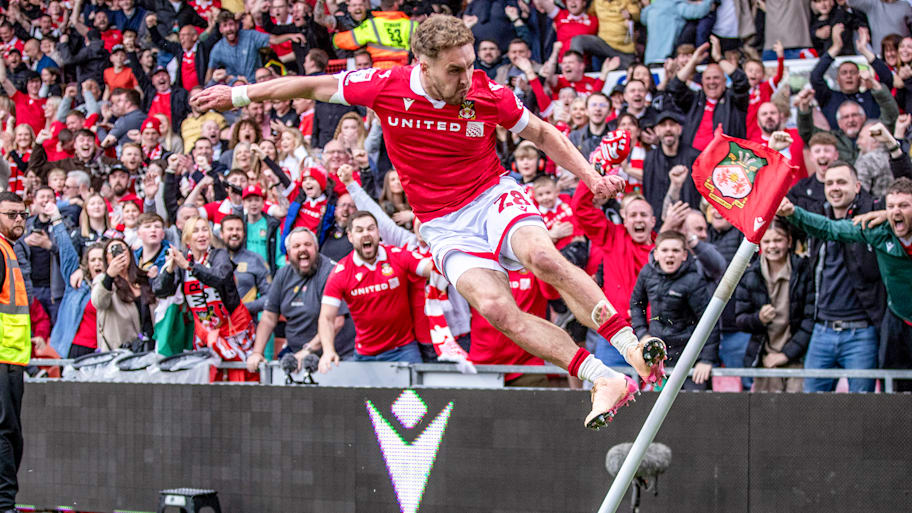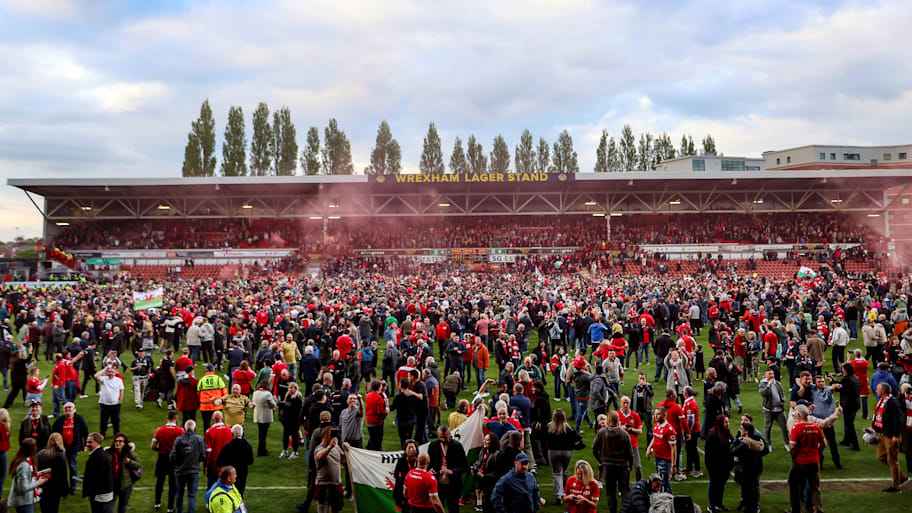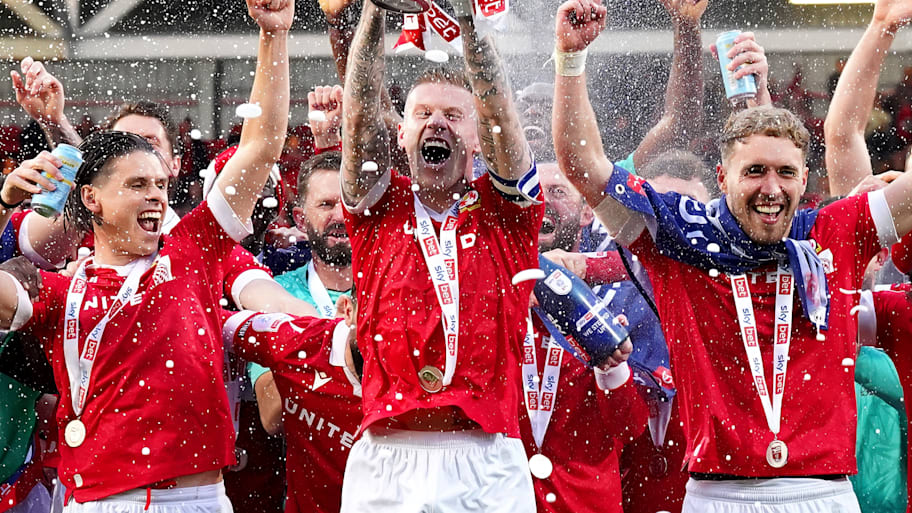On a September evening in 2020, Rich Fay walked out of a vegan restaurant called Shrub, having had a mushroom kebab with his future wife. He switched his phone back on and saw that he’d missed a text from a friend.
Then another text.
Then three more.
PING! PING! PING! PING! PING!
The texts were from fellow fans of Wrexham, the club stuck in the fifth tier of English football for the last 12 years.
“Mate have u seen this?”
“Ryan Reynolds?!?!”
“What the f--- is happening?????”
A few days earlier, a club statement had said that unnamed investors were looking to pour $2.5 million into Wrexham. But Ryan Reynolds? And fellow actor Rob McElhenney? Fay thought it was a joke. Then he got worried.

Fans had wondered why even a local car dealer would buy a club that had just finished in the lower half of the lowest nationwide professional league in England. The Red Dragons didn’t have a designated training ground. They played their home games at the crumbling Racecourse Ground, which they didn’t even own at the time. As someone who grew up in this blue-collar city in North Wales, once fueled by coal and steel, Fay says you wouldn’t just be made fun of for supporting Wrexham—you’d be made fun of for living in Wrexham.
He had a theory. “They’re both comedians,” says Fay, a journalist who cohosts the Wrexham podcast RobRyanRed. “I thought they might be making a mockumentary. Oh, look at this crap little football team.”
Less than five years after that September evening, Wrexham will play in the second tier of the English Football League (which is where Wrexham plays despite being located in Wales). They’ve been promoted three seasons in a row, a first in EFL history, which leaves one giant question: In the loss-making, rule-bending shark tank of British club ownership, how did the winners become the guy who plays Van Wilder and Deadpool, and the creator of a sitcom about some friends running an Irish bar in Philadelphia?
In the second episode of Welcome to Wrexham, the FX reality show that debuted in August of 2022, McElhenney sports a handlebar mustache in front of a white wall. Talking to the camera, he says, “Not sure what to get your special someone this holiday?”
Over upbeat guitar music, the screen switches to Reynolds: “Tired of opening the same old scarf or sweater? Try … Ifor Williams Trailers.”
Much like the ownership of Wrexham, the ad feels like a spoof but it’s not. Ifor Williams was the main sponsor when Reynolds and McElhenney took over the club from a fan trust in February 2021, and the clip reveals the secret sauce.
Advertising, straight and undistilled, sprinkled throughout the series. Episode 7 starts by listing the main sponsors, with logos and endorsing voice-overs from the owners: Ifor, TikTok, Expedia, Aviation Gin—the last of which is co-owned by Reynolds, who is also cofounder of the marketing firm Maximum Effort (you can tell). Wrexham later signed up United Airlines, HP, Gatorade, Meta Quest … you get the idea. There’s no subtlety here: Reynolds and McElhenney are telling us they’re trying to grow brand exposure, so here’s another ad, we’re doing this, it’s working, and we don’t mind that you know.
The deals are a catch for a club playing in front of about 12,000 fans every other week, but this was never about the locals. More than half of Wrexham’s income was generated outside of Europe during the 2023–24 season, the latest for which financial results are public. The stadium name has been sold off to STōK Cold Brew Coffee, a U.S.-based company that doesn’t even sell its product in Wales.
“Global brands such as TikTok, United Airlines and Aviation Gin realize that they can leverage off the appeal of Wrexham,” says Kieran Maguire, a finance academic and the author of The Price of Football. “And they want to be associated with the success of the club and also, of course, the success of the show.”
Reynolds and McElhenney also advertise to tens of millions of people on social media. They do interviews and podcasts and talk shows. “It’s crazy,” says Fay. “And now the revenues are insane.”
In 2020–21, the season in which Ryan and Rob took over the team, Wrexham generated a total of about $1.5 million in revenue. When playing in the fourth tier (League Two) in 2023–24, they earned nearly $33.7 million. That was more than 11 of the clubs in the second tier (the Championship), according to The Athletic, which estimated that the commercial income—like ad deals—ticked in at $24.9 million, more than five clubs in the Premier League. Even after three promotions, the brand has grown faster than the team.
🏴🇨🇦🇺🇸 pic.twitter.com/Vp4zlOfcNO
— Ryan Reynolds (@VancityReynolds) May 6, 2025
The revenue has given the club an enormous advantage. When in the fifth tier (the National League), the owners simply paid really good players lots of money to play for them. They lured Paul Mullin, the top goalscorer in the fourth tier, away from Cambridge United in 2021. They signed Ollie Palmer, a striker from third tier Wimbledon for a then club-record transfer fee of just over $400,000. “They were probably League One quality even when they were in the National League,” says Omar Chaudhuri, chief intelligence officer at Twenty First Club, which builds models that estimate team strength. There’s no deeper secret for how Wrexham got a good team. They bought one. Even better, most of their rival owners haven’t been able to spend this much on players, even if they’ve had the cash.
In the fourth tier, clubs must keep spending on players below 50% of annual revenue, and in the third tier the cap rises to 60%. The exception has been cash from equity investment, though that loophole closes this coming season. In the second tier it’s not a percentage, but a cap on how much clubs can lose over a rolling three-year cycle. These rules are meant to help clubs stay sustainable, and to make sure that a guy like Jeff Bezos can’t simply buy Grimsby Town and hoover up players with Amazon money.
So for a club to spend a lot, it has to earn a lot. While Reynolds and McElhenney financed much of the initial outlay, Wrexham has been powered by sponsor revenue—one of the few things worth more to modern football than actual money.
To their great credit, Reynolds and McElhenney know what they don’t know. One of their first and best moves was to hire Shaun Harvey, an executive who had worked for Leeds and Bradford City in the top tier, and had been the CEO of the English Football League. Signings? Stadium expansion? Harvey knows. He advised the owners to get manager Phil Parkinson. The owners basically said, “O.K., let’s do that.”
And then Parkinson said no, so McElhenney went after him, in the words of Reynolds, “like a dog with a bone.” McElhenney called Parkinson from a parking lot, where he spent the next 90 minutes selling the coach on the club.
This self-awareness alone elevates Reynolds and McElhenney above the far too many owners who seem physically unable to spend money on their club—their business—without meddling in the football stuff. Enough investors and entrepreneurs believe they are best suited to handpick coaches and players worth tens of millions of dollars, based merely on the same I-know-best hunches as the fan in the pub. It says something about English football ownership when two Hollywood actors are among the people most grounded in reality.

Instead, Reynolds and McElhenney have done what they do best, which is to give their audience a moving story. Welcome to Wrexham tears down the fourth wall to give viewers memes, reels, outtakes and self-deprecation, making it far funnier than the slew of unbearably polished club documentaries that flood streaming platforms. It’s also honest about the risk involved. As McElhenney tells Reynolds in the first episode, “There is a version of this story where we are the villains.”
The story was always at the center of the investment. Even the recommendation to buy Wrexham came from Humphrey Ker, a British screenwriter and actor who was working with McElhenney on the series Mythic Quest back in 2020. Ker told McElhenney to check out Sunderland ’Til I Die, the gritty Netflix documentary series about the giant club from northeast England that got stuck in League One for what would ultimately be four seasons. When McElhenney realized that clubs in English football can travel up and down the divisions, he told Ker, “We should do this.” Which meant buying an actual club.
He dispatched Ker to draw up a list of targets. Ker later told British GQ that his research amounted to scrolling Wikipedia and checking out the stats section of the video game Football Manager. Where others saw Wrexham as a backwater, Ker and McElhenney saw a wounded underdog. Wrexham is the third-oldest professional club in the world, and over the last 25 years the fans had been torched by threats of bankruptcy, a 10-point deduction for going into administration and an owner who tried to kick the club out of the stadium so that he could sell it. All of which affected the mood among the 60,000 people in the city. “The football club’s success is interlinked with the confidence of the town itself,” says Fay. “If the club is doing well, the town is doing well.”
The owners understood that, by lifting the club, they could change lives. Once Reynolds and McElhenney set foot in Wrexham in October 2021, having only watched the team on internet streams, they greeted fans, kids, pensioners, shop owners and even an “exorcist” tasked by the church with investigating paranormal activity. They posed for selfies, signed shirts, watched a powerchair game and downed shots with fans in The Turf pub next to the Racecourse. They hugged it out with the players, saying they could come to them “with anything.” According to Reynolds, one player called him and asked if he could book him a rental car.
When Wrexham didn’t get promoted in the first full season after losing in heartbreaking fashion in the promotion playoffs, the series showed us the despair in the people—the tears, the agony, the what’s gonna give us joy now?
When Wrexham did go up a year later, thousands of people lined the streets for an open-top bus parade, and as the fans sang Elvis Presley’s “Can’t Help Falling in Love,” Ker, now a director at the club, cried for the first time in 10 years.
When Wrexham reached the Championship with a 3–0 win over Charlton in April, it was Reynolds who broke down in tears. “These fans f---ing deserve it,” said Mullin.
Now though, Wrexham is in a place where the air is significantly thinner.
The Championship is the football version of a casino. One promotion away from the hyperlucrative Premier League, club owners gamble cash that can only be recouped by either finishing in the top two or winning the third promotion spot through a four-team playoff. “We refer to [the Championship] as the clown car of European football,” says Maguire. “It makes no sense whatsoever.”
Maguire says that in 10 of the last 12 years, the total wage bill of the 24 clubs has exceeded their revenue. “Before you’ve turned on the floodlights, before you’ve cut the grass, before you’ve even signed any players, clubs are losing money,” he says.
The clubs that have dropped down from the Premier League come armed with parachute payments, a stack of cash paid out for having hit the big time, even for just a year. Some will have revenue of $130 million, likely more than three times that of Wrexham. As Chaudhuri points out, the financial gap between top and bottom is far greater than in League One. “The slope gets steeper as you go up the pyramid,” he says.
Parkinson knows this all too well, having reached the Championship twice. “I remember when I took Bolton up [in 2017], it was, Phew! This is huge! in terms of the physicality and power in the division,” he said right after Wrexham’s promotion, and added that the jump in salaries is “incredible, mind-blowing.”
According to Twenty First Group, Wrexham was about the 20th-best team in the league at the start of this summer. “I’d be very surprised if they’re promoted straight away,” says Chaudhuri. “I think a mid-table finish would be a fantastic result for them.”
More challenges await. With 12,600 seats, the Racecourse is among the smallest stadiums in the league, and the construction of a new stand will temporarily reduce capacity. Tickets are already hard to find, and Fay says there could be a tipping point where Wrexham becomes unaffordable to locals, a trend that has spread across the top clubs in the Premier League. Fortunately for the locals, fan opinion matters. “Since Rob and Ryan have so much to lose, their credibility is on the line,” says Fay. “They don’t want to make any unpopular decisions.”

Damage trust among the community, and you rip out the heart of the show.
“What makes it even better is that this isn’t a state,” says Fay, referring to ownership groups such as the Saudi government’s Public Investment Fund, which owns Premier League club Newcastle United. “This isn’t some dirty businessman who’s got blood money. This is just two celebrities. And what’s on the line for them is not money, it’s reputation. Because if Wrexham fails, Ryan Reynolds fails.
“There aren’t many football teams or businesses where you genuinely like the guys in charge.”
A bigger question, given that the success has been driven by brand exposure, is what happens when the documentary stops. No series can run forever, even if It’s Always Sunny in Philadelphia is now airing its 17th season.
The fans might worry about the day the owners turn off the cameras, sell and leave. “They are a bigger brand than the football club itself,” says Maguire. “So how are you going to persuade global sponsors to continue to have that level of engagement with Wrexham if the owners are no longer attached to it?”
The exception, Maguire says, is if Wrexham gets to the Premier League, a global drama series in its own right. “Then to a certain extent [the club] should be able to become slightly more self-sufficient,” he says.
Fay thinks Wrexham needs the show less now than before. “The documentary gave us validity and a platform,” he says. “And now we’re on that stage. You can watch every Wrexham game in the U.S., so the fans who follow us will continue to do so. And if you get to the Premier League, you don’t need a documentary.”
Could other clubs copy Wrexham? Maguire thinks it would be difficult. “You’ll end up with football documentary fatigue,” he says. “What they do have is first-mover advantage. They’ve built up a cult following. They are also using the right people in front of the camera. We know Ryan Reynolds, it’s impossible to dislike him. So I think the chances of being able to repeat that are relatively remote.”
At least their rivals can jot down some lessons from Wrexham about what sport can be in 2025, when every player and team can be sold as content. To win in football, you don’t have to know everything about it. You don’t even have to know the rules, as long as you tell the best story. And as Reynolds and McElhenney know, the best stories are about people. The underdog was never the team, but the town.
More Soccer on Sports Illustrated
This article was originally published on www.si.com as How Ryan Reynolds and Rob McElhenney Launched the Rise of Wrexham.
